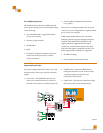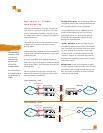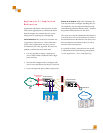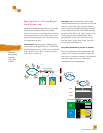
Communication without boundaries
1
Introduction
Today, businesses rely on the ability to conduct
transactions and support customer relationships
over the Internet. Delay-free access to information
is the key to businesses running smoothly.
Traditional network equipment and design is not
suitable to respond to the increasing demand on
availability and performance. The two key factors
in ensuring you can keep up with your customers’
demands are:
High Availability—Your clients should not be con-
cerned with your network problems. All they want
is 24/7 access without excuses. Load Balancing
provides transparent reliability—once configured
the P333R-LB gives worry-free, availability.
Removing Bottlenecks—High Availability is only
half the story; some network element along the way
may slow everything down. Any software-based
entity in your network, such as a firewall or server
can become a bottleneck. By adding more elements
in parallel and Load Balancing, you dramatically
boost bandwidth.
Load balancing allows you to simply divide
demand among multiple resources to ensure that
information flows freely.
The applications in this document show how
to deploy Load balancing using the P333R-LB
to maximize network performance by increasing
availability and removing bottlenecks.
What is driving the need for
Internet Traffic Engineering?
The Growth of eBusiness Applications: The explosive
growth in critical eBusiness applications has created
the need to distribute application services over
multiple servers for scalability and enhanced
availability. The problem with traditional network
devices is that many eBusiness applications, such
as eCommerce transactions (e.g., shopping carts),
search engine sessions, and individualized services
(e.g., changing your bank account information
online) require that the client communicate with
the same server for the entire session. This requires
content-aware switching, the ability to examine
the packet, and intelligently bind clients to a server
using a variety of criteria that may span multiple
TCP connections. This goes beyond the capability
of traditional L3-4 switches.
Security: Along with increased connectivity and
access to the corporate network from extranets
and eBusiness applications, comes greater risk
to network security. Traditionally, routers and
firewalls have been used to protect critical corporate
server resources, but as traffic demands grow, their
software-based filter processing capabilities hamper
access and response. This has created a need for
switches that can process an Access Control List
(ACL) at hardware-based speeds, while at the same
time mitigating external threats from Denial of
Service and spoofing attacks.
The Keys to a Better Network:
• High availability—
Users always have
access to resources
• Removing bottlenecks—
To ensure that servers,
firewalls, and other key
components are not
overloaded and limit
network performance.












